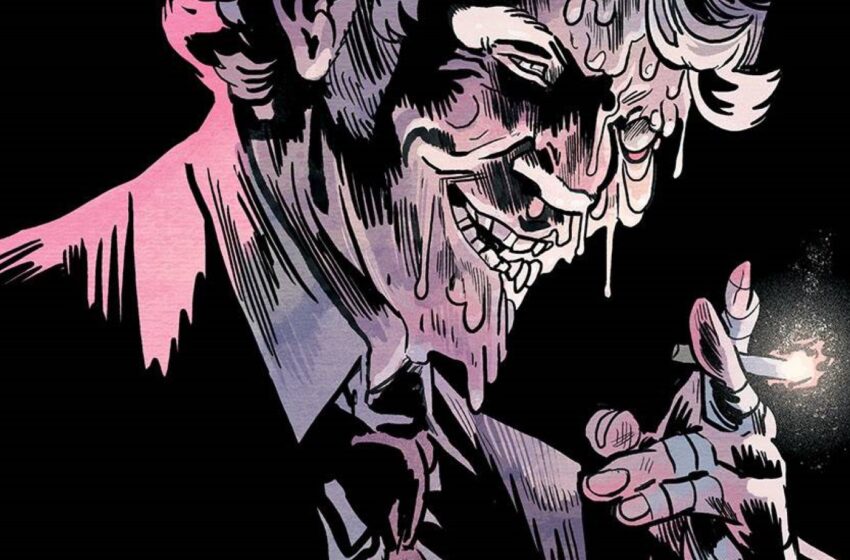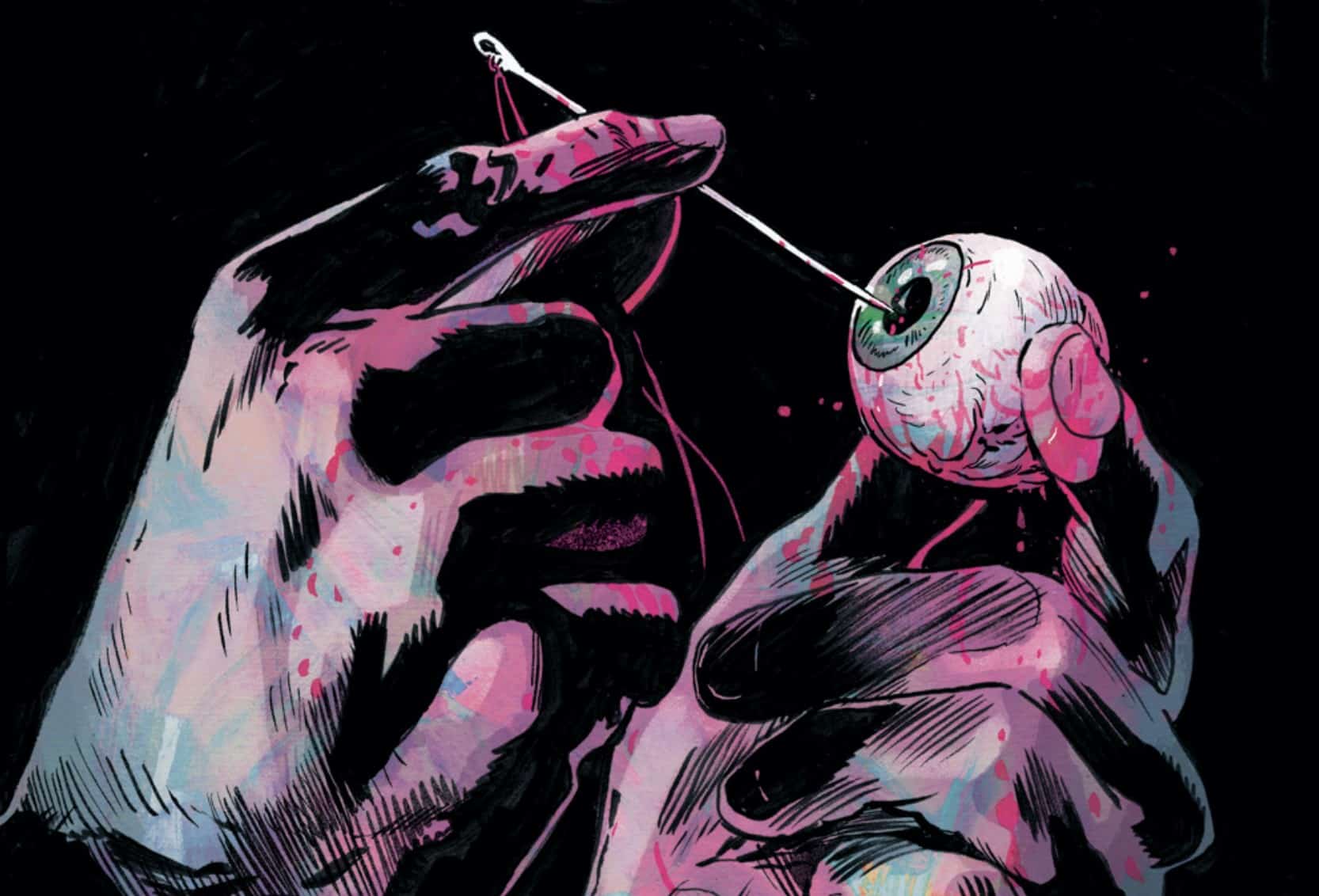The South Bronx is on fire, and a crooked cop can clear his debts if he helps it burn. But with each dirty deed, the Silver Coin gets hotter to handle. The Silver Coin #9 is written by Vita Ayala, with art, colors and lettering by Michael Walsh and color assists by Toni Marie Griffin.
Mark Turetsky: Ritesh, I’m glad you could join me at this New York coffee shop so we could talk business.
Ritesh Babu: So am I, Mark. So am I. It’s always fun to sit down with The Silver Coin.
No Horror Like the Truth

Mark: I think Walsh et al are continuing a pretty great streak with this issue. One thing I love about this series is that it seems like every issue kinda lulls you into thinking the comic is one thing and then reminds you, “Hey, in case you forgot, this is a horror comic.” You know? Like, this starts out as a great comic about a crooked cop, but then they introduce the faces of the sex workers melting like plastic doll heads? Sign me up.
Ritesh: That was such a surprising sequence. It kinda took me out for a moment, and then put me right back in. I think what I’m really digging thus far is how many different angles through which it approves its core ideas and anxieties. The Ram V casino issue is very different from the prior Rosenberg building fall issue, both of which are very different from this issue about ’70s NYC and its corrupt police. But they’re all so very clearly about the same larger machine and entity. They’re just coming at it from so many different angles, with so many different influences, that it’s a ton of fun to see play out. It makes sense given this sort of massive ensemble of varied creatives, and it’s a book taking full advantage of that. I’m quite pleased with the results thus far.
Mark: It really makes me wonder what the assignment is. Is Michael Walsh reaching out to writers and saying, “Here are the issues I’d like to touch on with his comic?” Or is he reaching out saying, “I’ve got this comic about a cursed coin, whaddaya got?” And then we’re seeing the sorts of things that comics writers want to write about, and drawing our own lines between them.
New York History

Ritesh: Hah, yeah. But regardless, however it works under the hood, I do love that it works. Here we have an issue about capitalism yet again, but through the lens of its chief violent agents, the cops. The entire reason the arson’s happening is for the sake of money. So that “the fixers” can get that insurance cash and make profit, while “the squatters,” the poor folks living in there and the communities in that space fall apart and are forever destroyed.
And when they are, the blame is put on the Black and Brown “crime” surrounding the area, whilst the white cop gets a medal and is adored. Only in cruel, absolutely certain death with undeniable proof is he written off by those in power and his truth revealed. But all it does is make you think once more: How many bastards like him were out there doing the same thing but had better luck, and thus didn’t get caught badly and die, and thus are forever honored as heroes? Even though they very much are not.
Mark: I appreciated the afterword (illustrated by Salmoée Luce-Antoinette) that puts this story into historical context. On the one hand, it’s a little clunky to come out after the story and say, “but you know, this stuff actually happened.” But on the other, apart from knowing the phrase “The Bronx is burning,” I wasn’t familiar with this particular bit of NYC lore, so I’m glad that it’s there, spelled out. It’s not just something that an ancient curse did, it’s shit that actually happened.
Ritesh: Yeah! It’s a book that’s been thoroughly about reality amidst all the supernatural and the weird and horrific. That’s what it’s served to illuminate. So it was nice to see a story so thoroughly rooted in reality, even as it put a genre lens and spin on it all. And I actually like that the backmatter was, well, backmatter. I’m trying to imagine this preceding the comic, and I feel like it would’ve drawn attention away. It would’ve been a wildly different effect, had we gone in thinking “This is real.” I like the idea of it being a retroactive realization by the end. That the horrific tale that feels so close to reality even amidst genre stuff … is actually that close to reality in terms of what it is drawing upon. That’s a wildly different effect and reading experience, I think, and it suits the title. You only learn the full truth later. Until then you’re just on that uncertain ride.
A Bad Barrel

Mark: And, even stepping away from the true history part of the story, just looking at it through a comics continuity lens, it’s fun to make connections between the issues. Like, the unhoused man who ends up picking up the coin at the end of last month’s issue shows up here, and The Detective (I don’t think he even gets a name) just takes the coin off him in this issue. It’ll be fun piecing together the route that the coin takes with this series’ convoluted timeline (Well, for certain definitions of fun, I suppose). What’d you think of the big reveal after The Detective has burned to death, that the man hiring him to set the fires is the deputy chief of police?
Ritesh: That The Detective doesn’t get a name feels crucial to me. He’s not just One Cop. He’s a representative of the idea of one. He could be any number of them. He is the role of The Cop.
And weirdly enough, I wasn’t surprised by the deputy chief reveal. Maybe it’s the radiation effect of having read one too many Batman comics, but right in the opener, I had the thought, “Oh, he looks like Jim Gordon.” And then he basically ended up being Jim Gordon! That got a good chuckle out of me. But yeah, it totally made sense. Of course it was the guy at the top ranks of the policing hierarchy. The system isn’t broken. It’s just working EXACTLY as it was meant to. And he represents that, even as he lies without a shred of shame on TV, despite having been the source of so many tragedies. They cause the problem. And then they collect the medals despite it. And they keep on doing so … until they die, and we’re all still left to deal with the shitshow they’ve left behind. There are no medals for that. Just a void, filled with pain.
Mark: And yet I think there’s something in this issue that doesn’t happen very often in The Silver Coin. There’s a sense of justice when our Big Guy dies. Not only is he disgraced, not only is he killed, but Cherish’s half-melted doll (another seeming visual nod to Batman?) is restored. The people who were murdered are still dead. The homes and possessions are still burned away. But there’s a tiny measure of, not things being set right, but maybe the slightest tick in that direction.
Loose Change
- Good on Ayala and Walsh not shying away from the characters casually dropping slurs into conversation, but also choosing not to print them themselves. We know what The Detective is saying. We don’t need to read it.
- There’s an impressive range of moods on a single panel during the fire at the beginning of the book. Everything from “Help! Please! My mom can’t walk!” to “You already there, man. Just let go!”
- Next month: it’s the end of another arc, and seemingly a direct continuation of the Covenant story that ended the first arc, by Michael Walsh solo.







